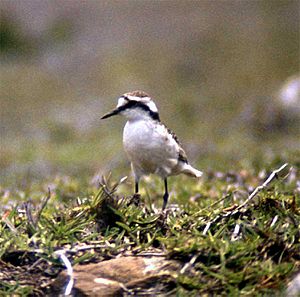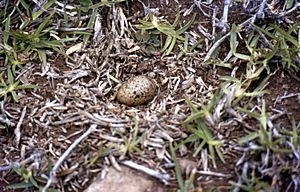Saint Helena plover facts for kids
Quick facts for kids Saint Helena plover |
|
|---|---|
 |
|
| Conservation status | |
| Scientific classification | |
| Kingdom: | |
| Class: | |
| Order: | |
| Genus: |
Charadrius
|
| Binomial name | |
| Charadrius sanctaehelenae |
|
The Saint Helena plover is a special little bird. People on the island of Saint Helena call it the wirebird. This small bird is a type of plover. It lives only on Saint Helena. This means it is endemic to the island.
People first wrote about the wirebird in 1638. It is the national bird of Saint Helena. You can see it on the top part of the island's coat of arms. Before 1998, the wirebird was also on some of Saint Helena's coins.
Contents
About the Wirebird
The Saint Helena plover is the only bird that lives only on Saint Helena. It is the only one left that is native to this South Atlantic island.
It is a small bird, about 15 cm (6 inches) long. It has long, thin legs that look like wires. This is why people call it the wirebird.
The wirebird's closest relative is the Kittlitz's plover. Some scientists think the wirebird is a type of Kittlitz's plover. But most zoologists believe they are two different species.
Wirebird Life and Habits
Wirebirds spend most of their time on the ground. They do not fly very often. You usually see them in pairs. Sometimes, young birds gather in small groups.
They look for food in grasslands or dry, semi-desert areas. Their favorite foods are snails, beetles, and other small creatures without backbones, called invertebrates.
Reproduction and Life Cycle
Wirebirds can breed all year long. But they mostly lay eggs during the dry season. This is from late September to January.
They build their nests on the ground. A female wirebird usually lays two eggs. After the young birds leave the nest, they move around the island in small groups.
Where Wirebirds Live
The Saint Helena plover lives only on the island of Saint Helena. It does not exist anywhere else in the world. In the last 20 years, they have used only about 30 square kilometers (11.5 square miles) of the island.
The best places to see wirebirds are Deadwood, Properous Bay Plains, and Woody Ridge. Wirebirds like areas with grasses, like pastures. They prefer flat, dry places with low plants, usually at middle elevations.
Protecting the Wirebird
The number of wirebirds is very low. This is because of changes in how land is used. Also, new predators have arrived on the island. These include rats, cats, and dogs.
A count in 2005 and 2006 showed a big drop in their numbers. There were only 235 wirebirds left. This was a 40 percent decrease in just five years! Luckily, their numbers have gone up a little since then.
The Saint Helena plover has been protected by law since 1894. Many groups are working to save this special bird. The Royal Society for the Protection of Birds is one of them. They have a project called "Enabling the people of St Helena to conserve the St Helena wirebird." This project is part of the Overseas Territories Environment Programme of the UK.
See also
 In Spanish: Chorlito de Santa Elena para niños
In Spanish: Chorlito de Santa Elena para niños




